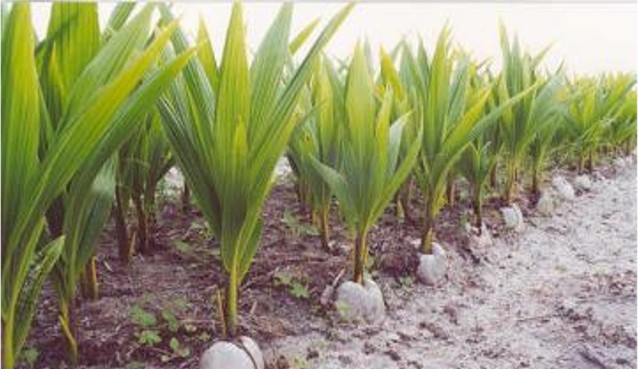Making Coconut Garden
How to produce dwarf coconut seedlings easily at home

Producing seedlings for domestic purposes, in addition to being easy, has almost no cost, requiring only some specific knowledge
In addition to being a beautiful ornamental plant for large gardens, farms and farms, the coconut tree is widely used in the consumption of coconut and coconut water and the use of its fibers and bark for the production of handicrafts and organic fertilizer.
READ MORE- How to make eggplant garden
The dwarf coconut tree, a variety that is very widespread on Brazilian farms due to the quality of its fruits, produces year-round, and its production cycle can last up to 30 years.
For commercial exploitation, that is, large-scale production in order to meet the growing market demand, growing dwarf coconut, although it has a great financial return, is a very costly activity, but producing seedlings for domestic purposes, in addition to being easy, is not it has almost no cost, requiring only some
specific knowledge.
Do you want to know how to get dwarf coconut seedlings at home step by step? See below!
1. step
Take a ripe coconut and make grooves in its shell, which must be cut from one end of the fruit to the other. It is extremely important that the cut does not pierce the endocarp, that is, the hardest skin that surrounds the pulp. This is because water must be preserved, because without it, the seed will not have enough nutritional reserves to sprout.
2.step
Make a drainage layer in a vase or bucket with a capacity between 10 and 15 liters. Simply fill the bottom of the chosen container with crushed stone or expanded clay and add washed sand until they are covered. Instead of sand, you can also use drainage blanket.
Without this layer, the soil in the pot will become very compact over time and with watering, as the accumulated water will not be able to drain out of the pot. Thus, the root of the coconut tree will rot.
3.step
Fill the pot with soil. It is very important that it is very light and uncompressed.

READ MORE-Tips for making flowerbeds in your garden
Coconut Production for Water Consumption :
“The dwarf coconut palm is a very demanding plant in terms of water, therefore, from the point of view of water conditions, heavier soils, which have a greater capacity to retain water, are ideal for cultivation.
However, these soils do not have good root aeration conditions and offer resistance to root penetration, which is not favorable to the good development of the coconut tree.
Therefore, from a physical point of view, light soils are not the most suitable for the development of coconut trees, as their low water retention capacity can be supplied by irrigation.”
4. step
Plant the coconut, taking care to place the side where it was attached to the tree facing up. Don't bury it completely: leave about three fingers of the seed out of the ground.
5. step
Water constantly. As seen in the third step, the dwarf coconut is very demanding in terms of water, so it is necessary to keep the seed always hydrated.
When the coconut tree reaches about 80 cm in height, it is time to transplant it to its final location, that is, to the soil, remembering that it must be well drained and, preferably, low in acid and rich in organic matter. . It should not be left in a vase, as this will not be able to support its root system.

The transplanting hole should be 60 cm x 60 cm x 60 cm. Mix the fertilizer of your choice with the first half of the soil taken from the hole. Throw this mixture at the bottom of the hole, place the plant and finish filling it in with the rest of the soil to which the fertilizer has not been mixed. Don't forget to water abundantly right after.
Ready! Now just wait for the development of the plant to harvest the first fruits!


Comments
Post a Comment